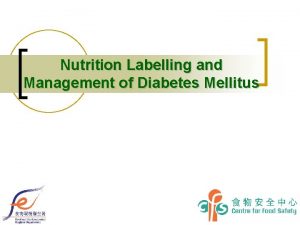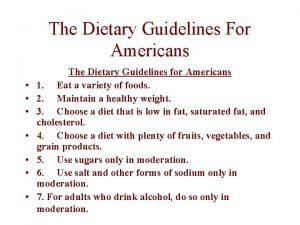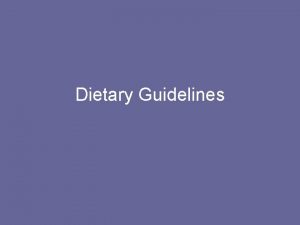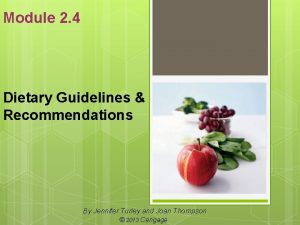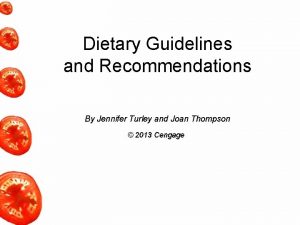Dietary Guidelines and Recommendations Module 2 4 Dietary






- Slides: 6

Dietary Guidelines and Recommendations Module 2. 4

Dietary Guidelines, 2010 • The guidelines are based on the recommendations put forward by the 2010 Dietary Guidelines Advisory Committee. The Committee was composed of scientific experts who reviewed analyzed the most current information on diet and health and incorporated it into a scientific, evidence-based report. • Based on the most recent scientific evidence review, the guidelines provides information and advice for choosing a healthy eating pattern—namely, one that focuses on nutrientdense foods and beverages, and that contributes to achieving and maintaining a healthy weight. Such a healthy eating pattern also embodies food safety principles to avoid foodborne illness. • Seventh edition release of dietary guidelines

Dietary Guidelines, 2010 Americans are overweight or obese and under nourished. Individual, societal, and environmental efforts and interventions are called for. • Four directives related to reducing overweight and obesity, Calorie, sodium, solid fat, added sugars, refined grains, and non-nutritious food intake, and increasing plant-based eating and physical activity. • Nine sustainable food environment changes centered on improving nutrition, food, and cooking literacy and skills, physical education, financial incentives and agricultural programs that ensure healthy and sustainable eating and food security and portion control. • Eight topic-specific finding areas that promote energy balance and weight control, adequate nutrient, protein, and water intake, whole grains, food safety, and limited SFA (<7%), cholesterol (<300 mg/day), sodium (<2, 300 mg /day to 1, 500 mg/day) and alcohol intake.

Dietary Guidelines, 2010 1. The 2010 Dietary Guidelines are intended to be used in developing educational materials 2. Aid policymakers in designing and carrying out nutritionrelated programs, including Federal nutrition assistance and education programs. 3. The Dietary Guidelines also serve as the basis for nutrition messages and consumer materials developed by nutrition educators and health professionals for the general public and specific audiences, such as children. 4. The Dietary Guidelines for Americans encourages individuals to eat a healthful diet — one that focuses on foods and beverages that help achieve and maintain a healthy weight, promote health, and prevent chronic disease.

Dietary Guidelines, 2010 Less: • • • Sedentary behaviors Large portions Saturated fat and trans fat Added sugars and sodium Snacking Fast food Mindless eating Heavy alcohol consumption Foodborne illness Obesity and chronic disease prevention More: • Physical activity • Appropriate portions • Foods high in essential nutrients • Home cooking • Plant based and whole foods • Seafood • Nutrition and physical education • Financial incentives to eat right • Food safety and security • Good health and function

AHA and ACS Recommends American Heart Association healthy eating plan: • Consume a diet rich in vegetables, fruits, and whole-grain. Consume fish(twice/week, esp. oily). Minimize the intake of beverages and foods with added sugars. – Healthy Body weight. – Desirable lipid profile: <300 mg chol, SFA <7%, PUFA up to 10%, MUFA up to 15%, avoid trans fatty acids (<1%). – Desirable blood pressure: sodium between 1, 500 and 2, 300 mg/day – Alcohol in moderation if any. • American Cancer Society: Eat a variety of healthful foods, with an emphasis on plant sources. – 5 or more fruits and vegetables – whole grains not refined grains – limit high fat red, processed meats and alcohol • Maintain a healthy body weight throughout life, be physically active.






